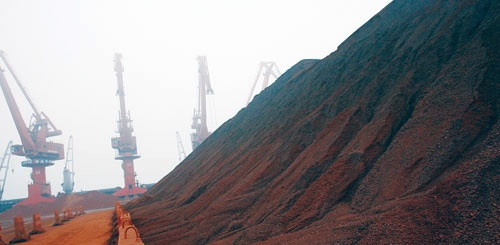


By Sun Qizi (孙琦子)
Issue 620, May 20, 2013
News, page 7
Translated by Zhu Na
Original article: [Chinese]
Chinese enterprises are expanding overseas rapidly and on a large scale, but many of these projects are seeing poor returns. China Mobile Communications Corporation (CMCC), for example has invested in six major overseas projects since 2005. But according to data from the National Audit Office, among these projects three have suffered losses altogether totaling nearly 3.2 billion yuan.
Why do so many of these projects fail to take off? How does one choose an overseas investment that will see a reasonable return? Economic Observer asked Xu Jing (许京), vice president of China International Trade Association, Chen Weidong (陈卫东), chief economist at the Energy Economics Research Institute of China National Offshore Oil Corp, Andrew Zhu (朱桉), a tax partner and cross-border mergers and acquisitions specialist at Deloitte, and Claire Yang, managing director of Accenture Greater China.
Economic Observer: How profitable are Chinese companies’ overseas investments at the moment?
Xu Jing: It depends. Private enterprises actually aren’t doing too bad, but centrally-administered state-owned enterprises (COEs) don’t have a very optimistic profitability situation. CITIC Pacific’s investments in Australian iron ore mines, for instance, have lost a lot of money.
In general, private enterprises have gone ahead of COEs with overseas investment. For example, in some African countries, COEs let private enterprises go to invest first then follow with their own investment later. This is because COEs trust private enterprises’ judgment.
As for the overall profitability situation of overseas projects, one-third are successful and one-third experience losses. But as long as those money-losing projects don’t declare bankruptcy, enterprises can still keep them on the books as assets.
Claire Yang: 37 percent of enterprises say that in the past three years their overseas projects made profits. The rest said they experienced meager returns or losses.
Andrew Zhu: Based on the cases we are dealing with now, 70 to 80 percent of overseas mergers and acquisitions (M&A) focus on energy and mineral resources, and a few are in manufacturing. M& A in oil-gas are doing well. Most enterprises expect to make their investment back in five to 10 years, and in the best case, within three years.
Because of the volatility of commodity prices during the first half of the year, recently overseas investment in minerals hasn’t been very good and many projects have been suspended. For solar and wind energy, because of the European economic downturn, many subsidies have been canceled and there are almost no new projects.
EO: Why haven’t Chinese enterprises’ overseas projects achieved the expected returns?
Xu Jing: There used to be a quota requiring COEs to invest a certain amount in overseas projects each year. This was one measure in the performance review of these enterprises. So how good do you think the results could be? Previously, the enterprises themselves decided which overseas projects to invest in. But over the past two years, the State-owned Assets Supervision and Administration Commission (SASAC) has begun instituting restrictions and requiring COEs to get approval from them on overseas investments. This is in order to reduce losses.
Claire Yang: For many Chinese enterprises, whether they can be profitable or not depends on whether they have overall strategic planning. Many enterprises haven’t put their strategies into practice on projects, and have also failed to conduct a thorough investigation and make detailed plans.
Chen Weidong: The entrepreneur is the main player in investments abroad. Therefore, decisions regarding the potential and the timing of investments should be left to entrepreneurs, not the government. Currently, entrepreneurs lack independent judgment on overseas investments and always follow the government. Enterprises should expect to see returns in the long-term, but the government administrative cycle is only five years.
EO: What difficulties and risks are Chinese enterprises facing in overseas investment?
Claire Yang: According to a report done by Accenture this year on Chinese enterprises’ global dreams, internationalization by these enterprises faces five major difficulties. The first is the lack of an overall international strategy. In the survey, among those companies that want to continue to actively expand investment overseas, only 26 percent believe they have the capability to actually manage their expansion. The second difficulty is weak implementation ability. Only 43 percent of the Chinese enterprises thought they already had the ability to carry out and implement an international strategy.
The third problem is that management and control infrastructure is lacking. Only 29 percent of the enterprises had established adequate IT infrastructure. The fourth problem is in human resources, which includes issues like managing cultural differences and attracting local talent. The final difficulty is integrating the culture of the Chinese enterprise with the local culture of the project and establishing a collaborative atmosphere with shared values and a global strategy.
Chen Weidong: Currently Chinese enterprises going abroad for investment face risk from four notable difficulties: First is the assessment of resources and the industry’s long term value. The second is making judgments regarding regional politics and state relations. The third is the risk associated with cultural integration. The fourth is the specific operation risk.
The largest risk is the first one, because once the direction is wrong, no matter what adjustments are made, it will always be wrong. So it’s very important to choose the right general direction.
EO: How will Chinese enterprises’ overseas investment develop over the next few years?
Xu Jing: Chinese enterprises’ international strategies still need to develop significantly in the future. Now enterprises mainly invest in energy and resources. In the future, in addition to raw materials, they’ll make moves toward higher quality resources, including acquisition of luxury brands. Another trend in the future will be a shift from taking on high-profile investments to using less conspicuous investment channels, like trust funds.


